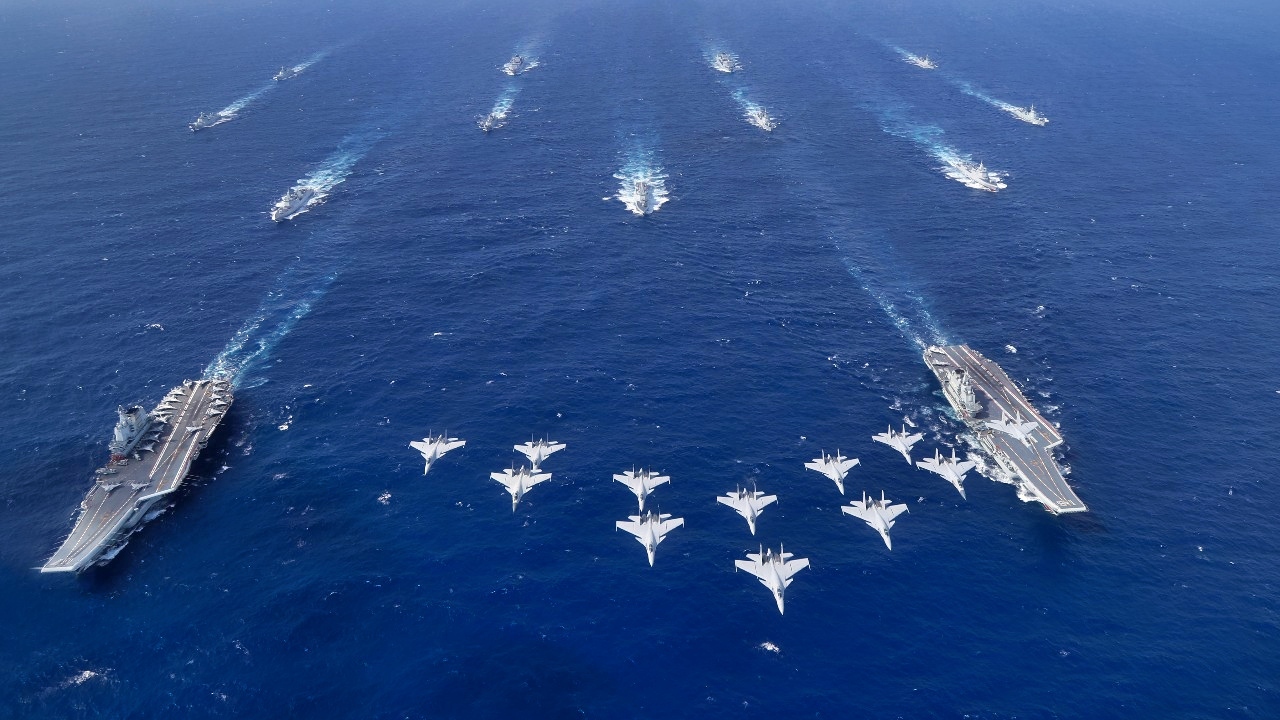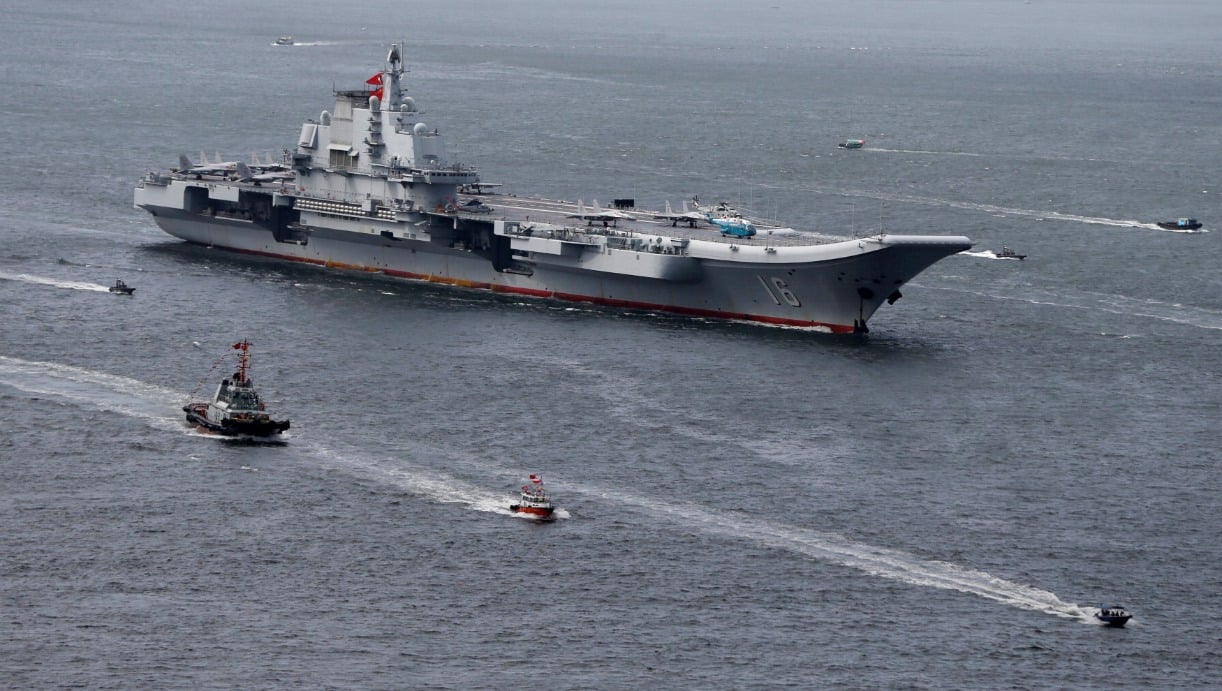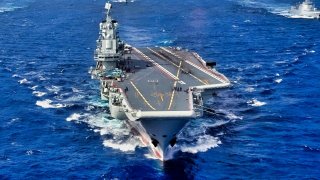Study the Photo: China Is Flexing Its Aircraft Carrier 'Muscles'
China recently demonstrated its naval strength with its first dual aircraft carrier formation exercise involving the Liaoning and Shandong carriers in the South China Sea, showcasing a dozen J-15 fighters and a powerful escort fleet.
What You Need to Know: China recently demonstrated its naval strength with its first dual aircraft carrier formation exercise involving the Liaoning and Shandong carriers in the South China Sea, showcasing a dozen J-15 fighters and a powerful escort fleet.

-This exercise marks the evolution of China’s aircraft carrier ambitions, rooted in decades of study, including insights gained from the ex-HMAS Melbourne and the Soviet-era Varyag (now Liaoning).
-With the anticipated addition of the Fujian and potential nuclear-powered carriers, the PLAN aims to expand its carrier fleet to six by the mid-2030s, underscoring China’s commitment to strengthening its naval power.
Going to PLAN: China Conducted First Dual Carrier Formation Exercise
For Beijing, it was all going to plan for the People's Liberation Army Navy. Just over a decade ago, The Type 001 Liaoning entered service – becoming China's first aircraft carrier. Now, this week the PLAN carried out its first dual aircraft carrier formation exercise in the South China Sea as the Type 001 operated alongside the Type 002 Shandong as a dozen Shenyang J-15 Flying Shark carrier-based fighters flew overhead.
The carriers were supported by three Type 055 guided-missile destroyers (DDGs), five Type 052D DDGs and one Type 054A guided-missile frigate (FFG). A pair of Type 091 fast combat supply ships, which respectively support the PLAN's carrier strike groups (CSG) on deployments, were also present.
It was meant to be a massive display of Chinese naval military might, and one that was shared to the masses on state broadcaster CCTV, as well as via the Chinese social media platform Weibo.
"The event is notable also insofar as CV-17 Shandong has been in service for five years now. Other naval services previously jumped quickly on the opportunity of showing off newly commissioned carriers operating together," Naval News reported, and further highlighted how the UK's Royal Navy saw its Queen Elizabeth-class operating together, as did India with its INS Vikrant and INS Vikramaditya just last year.
Beijing just took a bit longer to carrier out its dual carrier formation exercise.
Origins of the Chinese Aircraft Carrier Program
What is notable about Beijing's carrier ambitions is that they go back decades. However, Chinese shipbuilding capabilities couldn't match those ambitions, and instead it gained experience slowly and steadily.
In 1985, Beijing bought the ex-Australian HMAS Melbourne (R21), a Majestic-class light aircraft carrier that was operated by the Royal Australian Navy (RAN) from 1955 until 1982. It had been the third and final conventional carrier used by the RAN.

The warship had been laid down as HMS Majestic during World War II and was launched in 1945. She was nearing completion when the war ended, and work progressed slowlyhowever many lessons learned during the war related to carrier design and operation were then incorporated into the ship’s modernization program. The ship, which was actually designed as a somewhat "disposable warship" that would be retired after the war ended, soon found life with the RAN.
After decades in service followed by time spent in a mothballed state, the ship was officially retired and sold for scrap to China for $1.4 billion. However, when the ship arrived in China in 1985 for the scrapping project, engineers studied the World War II warship in detail. The ship was antiquated by that time, and the Australians had removed all the modern and sensitive technology, but that didn't stop Chinese engineers from reportedly showing special interest in equipment such as Melbourne's catapults, arrestor wires, and aircraft lifts/elevators.
The flight deck was not only studied but was also dismantled and put ashore where PLAN pilots used it for landing practice. It was copied and a replica was used to launch aircraft. Much of the carrier remained in existence until at least as late as 1994 and it gave Beijing valuable insight into carrier operations. The scrapping efforts only began in earnest in 1994 and took several more years to complete.
The next great leap forward in aircraft carrier-based technology occurred after the dissolution of the Soviet Union in 1991.
Enter the Type 001
Launched in November 1988, the unfinished Kuznetsov-class aircraft carrier Varyag was transferred to Ukraine in 1992 – but Kyiv was unable to complete the vessel and instead sold it to Chinese army basketball star-turned-business tycoon Xu Zengping.
It was designated scrap metal, while the official plan was to see it converted it into a floating casino. However, Xu had another idea; the carrier could be completed for the PLAN.
According to a 2015 report from The Diplomat, the cost of the hulk and its transit to Macau cost $120, "small change for a government, but a mind-boggling sum for an individual. Xu gambled that a grateful Beijing would add the ship to the PLAN and reimburse him for it."
As the story was told, Beijing accepted the carrier, but never paid Xu! Instead, China was gifted with what would become its first carrier.
Beijing eventually refurbished the vessel as the Shi Lan before it was renamed Liaoning, after its northeastern province. Completed in 2012, the Type 001 allowed the People's Liberation Army Navy (PLAN) to begin its first carrier program, leading to the development of the domestically built Type 002 Shandong.
This past August, the People's Liberation Army Navy (PLAN) completed the third sea trials of its Type 003 Fujian, its second domestically-built aircraft carrier – and the first to be equipped with advanced electromagnetic catapults that are employed to launch aircraft.
The PLAN has revealed a goal of having six carriers in service by the mid-2030s, and Beijing is expected to soon reveal plans for its fourth aircraft carrier. Speculation abounds that the next carrier could be nuclear-powered, indicating that China will continue to improve its naval capabilities.
Author Experience and Expertise: Peter Suciu
Peter Suciu is a Michigan-based writer. He has contributed to more than four dozen magazines, newspapers, and websites with over 3,200 published pieces over a twenty-year career in journalism. He regularly writes about military hardware, firearms history, cybersecurity, politics, and international affairs. Peter is also a Contributing Writer for Forbes and Clearance Jobs. You can follow him on Twitter: @PeterSuciu. You can email the author: [email protected].
All images are from the Chinese Military.


